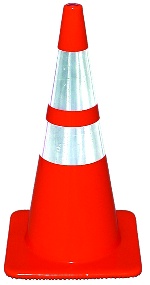A Guide to Selecting The Right Traffic Cones
When selecting traffic cones, the size, shape, and color you choose depend on various factors and specific requirements. Understanding the different types of traffic cones can help you make the right decision for your needs. Below, we explore the types of traffic cones available and key considerations to keep in mind when choosing the best option for your situation:
Learn about Different Types of Traffic Cones
Traffic cones are essential tools for traffic management, ensuring safety and clear direction in various situations. From road closures to pedestrian crossings, there are many types of traffic cones available to suit specific needs. This guide provides an overview of the different types of traffic cones, their uses, and features to consider.
Available sizes and associated uses
The most popular sizes of cones along with their common uses are as follows:
- 12 inch cone (commonly used for little league football, soccer and other sports)
- 18 inch cone (commonly used for sports and traffic, has optional reflective collar)
- 28 inch cone (commonly used for traffic & road closure, optional reflective collar)
- 36 inch cone (commonly used for traffic & road closure, optional reflective collar)
Using cones to close a road
When closing a road, it’s crucial to use traffic cones that are a minimum of 28 inches in height. Larger cones are necessary to ensure maximum visibility, helping motorists recognize the closure and avoid potentially dangerous mistakes. Smaller cones, such as 12 or 18-inch models, are inadequate for this purpose and should be avoided in road closure scenarios.
Night Time Use of Cones
For nighttime road closures or low-light conditions, traffic cones must include two reflective collars. These collars enhance visibility by reflecting headlights, ensuring drivers can clearly see the cones in the dark. Many cones can be customized with reflective materials before shipping, making them suitable for night use.
Two General Types of Manufactured Cones
There are two primary types of manufactured traffic cones:
- Flow Molded Cones: These cones are made of a single material, featuring UV-stabilized brilliant colors layered over bright white for maximum light reflection. They are durable and offer excellent visibility.
- Injection Molded Cones: These cones have a black base made from recycled PVC, providing reliable, skid-resistant stability. The black base also makes them more environmentally friendly by repurposing materials.
42 inch grabber cones
Grabber cones are a versatile option, standing at 42 inches tall with a handle on top for easy pickup and deployment. These cones feature a mounting hole in the handle for attaching barricade flashers. Their bases, made from recycled rubber, come in different sizes and weights, providing stability. The bases are easy to attach, and grabber cones are designed to stack efficiently, even with their bases, saving storage space.
Plastic Delineators
Plastic delineators differ from traditional cones, featuring a tube-like shape with handles for easy transport. Two common types are:
- Looper Tubes: These feature a loop handle, ideal for threading caution tape or plastic chain.
- Grabber Tubes: These have a grip handle similar to grabber cones, making them easy to lift and move.
Unlike cones, delineator tubes don’t stack with their bases attached. To store or transport large quantities, you must remove the bases and stack the tubes on their sides.
In-Mold Stenciling
Custom in-mold stenciling is an option for cones, allowing you to add permanent markings for added safety and direction. Examples of common stenciled notices include:
- Reserved
- Bus zone
- No parking
- Company logos
These markings are ideal for traffic control and branding purposes.
Traffic Cone Colors
Traffic cones are available in two main colors: orange and fluorescent green.
- Orange Traffic Cones: Commonly used for construction sites, road closures, and parking markers.
- Fluorescent Green Traffic Cones: Typically designated for fire, EMS, and pedestrian crossing purposes.
Choosing the right color depends on your specific needs, but these options cover most use cases.
Increase Safety With The Right Traffic Cones
Understanding the different types of traffic cones and their specific uses can help ensure safety and efficiency in a variety of settings. Whether you’re managing a construction site, organizing an event, or enhancing roadside safety, choosing the right cone for the job is essential. If you’re ready to equip your team with high-quality traffic cones, consider ordering a pallet of traffic cones to meet your bulk needs or browse our traffic cones selection. With the right tools in place, you can create a safer, more organized environment for everyone involved.

